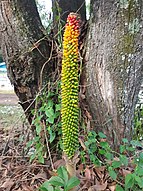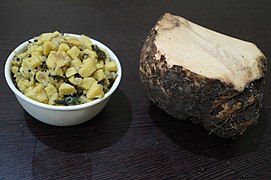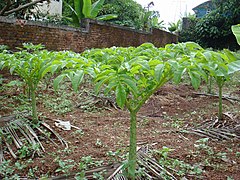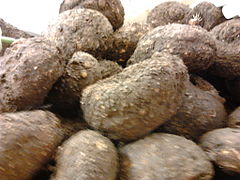| Elephant foot yam | |
|---|---|

| |
| Wild elephant foot yam from the Philippines | |
|
Scientific classification
| |
| Kingdom: | Plantae |
| Clade: | Tracheophytes |
| Clade: | Angiosperms |
| Clade: | Monocots |
| Order: | Alismatales |
| Family: | Araceae |
| Genus: | Amorphophallus |
| Species: | A. paeoniifolius
|
| Binomial name | |
| Amorphophallus paeoniifolius | |
| Synonyms [2] | |
| |
Amorphophallus paeoniifolius, the elephant foot yam [4] or whitespot giant arum, [5] [6] is a tropical plant native to Island Southeast Asia. It is cultivated for its edible tubers in Southeast Asia, South Asia, Madagascar, New Guinea, and the Pacific islands. Because of its production potential and popularity as a vegetable in various cuisines, it can be raised as a cash crop.
Origin
The elephant foot yam is used as food in Island Southeast Asia, Mainland Southeast Asia, South Asia, New Guinea, Oceania, and Madagascar. Its origin and center of domestication was formerly considered to be India, where it is most widely utilized as a food resource. But a genetic study in 2017 has shown that Indian populations of elephant foot yams have lower genetic diversity than those in Island Southeast Asia, therefore it is now believed that elephant foot yams originated from Island Southeast Asia and spread westwards into Thailand and India, resulting in three independent domestication events. From Island Southeast Asia, they were also spread even further west into Madagascar, and eastwards to coastal New Guinea and Oceania by the Austronesian migrations, though they may have spread south into Australia without human intervention. [7] [8] [9]
Description
Flowering
The plant blooms annually around the beginning of the rainy season. The flower bud emerges from the corm as a purple shoot, and later blooms as a purple inflorescence. The pistillate (female) and staminate (male) flowers are on the same plant and are crowded in cylindrical masses as an inflorescence. The top part is responsible for secreting mucus that gives off a putrid, pungent smell that is used to attract pollinating insects, the middle part of the inflorescence contains staminate, and the base of the inflorescence contains pistillate. The stigmas of the female flowers will be receptive on the first day of the bloom, when the pungent smell draws pollinating insects inside, and the inflorescence closes, trapping them for a night to allow the pollen deposited on the insect to be transferred to the stigmas.
Later in the second day, the female flower is no longer receptive to pollens, the male flowers start to bloom, and the inflorescence opens again. This allows the pollen to be deposited on the emerging insects to pollinate other flowers, while preventing the pollen from the same inflorescence fertilising itself, preventing inbreeding.[ citation needed]
In 24–36 hours, after the first bloom of the inflorescence, the inflorescence's female flowers start developing into berries bright red fruiting bodies, and other parts of the inflorescence start wilting away. The berries are red when ripe and are not quite round, being subglobose or ovoid. [10]
While the flowers are in bloom they also produce heat.
Uses
As food
-
With thoran prepared in Kerala style cuisine
-
Curry made using flower
In Indian state of West Bengal, Assam and in neighbouring country Bangladesh, it is called Ol (ওল/ওল কচু). It is usually eaten as mashed or fried or added to curries and, more rarely used in pickle or to make Ol chips. [11] In some households, the green leaves and stems are also cooked as green vegetables. [12]
In Maharashtra, Uttar Pradesh and Gujarat, It is called Suran.
In Bihar, it is used in oal curry (i.e. Elephant Foot curry), oal bharta or chokha, pickles and chutney. [13] Oal chutney is also called Barabar chutney as it has mango, ginger and oal in equal quantities, hence the name barabar (meaning "in equal amount").
In Chhattisgarh, it is called Zimmikanda or Zaminkand and eaten as curry, being a delicacy among people of Chhattisgarh.
In Tripura, it is called Batema and prepared by making a paste with sodium bicarbonate (baking soda) and water to remove its raphides (calcium oxalate needles). The paste is shaped into buns and boiled with water containing baking soda, after which the water is discarded. The buns are then cut into pieces and combined with fresh garlic paste and mosdeng (a spicy paste of dried fish/shrimp and chili). Also, the leaves and stems are eaten by chopping them into pieces and frying.
In Karnataka, it is called Suvarnagadde.
In Southern India, especially Kerala, it is known as Chena (ചേന), the tuber has been a part of people's diet for centuries. In Tamil it is called kaaraa karanai kizangu(காறாக்கரணைக் கிழங்கு), chénaikkizangu (சேனைக்கிழங்கு). It is mainly served as steamed pieces (പുഴുക്ക്) along with traditional chutney made of green chilli, coconut oil, shallots and garlic although the curry preparation is also common as a side dish for rice. It is made into a thick chutney (masiyal, மசியல்), typically eaten as an accompaniment with a rice dish. It has served as the main source of carbohydrates especially during the famine-stricken days of the region in the past along with the more popular tapioca. The flower bud before it blooms is also used for making curry. All parts of the flower can be used for making different types of side dishes.
In Nepal, it is called oal, kaan or suran and is grown mainly in the southern plains of the country. Its curry is consumed in Jitiya and Deepawali festivals.
In the Philippines, it is known as pongapong. The young leaves, stems, and corms are consumed as vegetables or turned into desserts. They are thoroughly cooked to destroy the stinging oxalate crystals. [14]
As medicine
The elephant-foot yam is widely used in Indian medicine and is recommended as a remedy in all three of the major Indian medicinal systems: Ayurveda, Siddha and Unani. [15] The corm is prescribed in those systems for a variety of ailments. The tuber is reported to be useful in treatment of piles. [16]
Cultivation
A. paeoniifolius suffers from Dasheen mosaic virus. [17]
Culture
In the epic drama film Mother India, the protagonist Nargis finds a small piece of elephant foot yam while ploughing her field during severe famine.[ citation needed]
See also
- Carrion flower
- Amorphophallus titanum
- Domesticated plants and animals of Austronesia
- Alocasia macrorrhizos
- Colocasia esculenta
- Cyrtosperma merkusii
Notes and references
- ^ Romand-Monnier, F. (2013). "Amorphophallus paeoniifolius". IUCN Red List of Threatened Species. 2013: e.T44393336A44531586. doi: 10.2305/IUCN.UK.2013-2.RLTS.T44393336A44531586.en. Retrieved 19 November 2021.
- ^ a b "Amorphophallus paeoniifolius". World Checklist of Selected Plant Families (WCSP). Royal Botanic Gardens, Kew. Retrieved 5 February 2017.
- ^ Nicolson, Dan Henry (1977). "Nomina conservanda proposita - Amorphophallus (Proposal to change the typification of 723 Amorphophallus, nom. cons. (Araceae))". Taxon. 26 (2/3): 337–338. doi: 10.2307/1220579. JSTOR 1220579.
- ^ "Amorphophallus paeoniifolius". Germplasm Resources Information Network. Agricultural Research Service, United States Department of Agriculture. Retrieved 5 February 2017.
- ^ "Amorphophallus paeoniifolius". Integrated Taxonomic Information System. Retrieved 6 December 2014.
- ^ "Amorphophallus paeoniifolius (Dennst.) Nicolson - whitespot giant arum". Natural Resources Conservation Service, United States Department of Agriculture.
- ^ Santosa, Edi; Lian, Chun Lan; Sugiyama, Nobuo; Misra, Raj Shekhar; Boonkorkaew, Patchareeya; Thanomchit, Kanokwan; Chiang, Tzen-Yuh (28 June 2017). "Population structure of elephant foot yams (Amorphophallus paeoniifolius (Dennst.) Nicolson) in Asia". PLOS ONE. 12 (6): e0180000. Bibcode: 2017PLoSO..1280000S. doi: 10.1371/journal.pone.0180000. PMC 5489206. PMID 28658282.
- ^ McClatchey, Will C. (2012). "Wild food plants of Remote Oceania". Acta Societatis Botanicorum Poloniae. 81 (4): 371–380. doi: 10.5586/asbp.2012.034.
- ^ Horrocks, M; Nieuwoudt, MK; Kinaston, R; Buckley, H; Bedford, S (13 November 2013). "Microfossil and Fourier Transform InfraRed analyses of Lapita and post-Lapita human dental calculus from Vanuatu, Southwest Pacific". Journal of the Royal Society of New Zealand. 44 (1): 17–33. doi: 10.1080/03036758.2013.842177. S2CID 128880569.
- ^ Quattrocchi, Umberto (2012). CRC World Dictionary of Medicinal and Poisonous Plants: Common names, scientific names, eponyms, synonyms, and etymology, Volume 1 A–B. Boca Raton, Florida: CRC Press (Taylor & Francis). p. 253. ISBN 978-1-4398-9442-2.
- ^ "Ol Bhaate | Mashed Elephant Foot Yam | Sooran ka Chokha from seasonalflavours.net". www.fooderific.com. Retrieved 2020-07-31.
- ^ "ওল সাক বাটা | Ol Shaak bata recipe in Bengali |". Retrieved 2021-01-05.
- ^ Nedunchezhiyan, M.; Misra, R. S. (2008). "Amorphophallus tubers invaded by Cynodon dactylon". Aroideana. 31 (1). International Aroid Society: 129–133.
- ^ Polinag, Mercedita A. (2003). Food From the Wilderness (PDF). DENR Recommends. Vol. 12. Ecosystems Research and Development Bureau, Department of Environment and Natural Resources, Republic of the Philippines.
- ^ Khare, C. P. (2007). Indian Medicinal Plants: An Illustrated Dictionary. Berlin: Springer Verlag. ISBN 978-0-387-70637-5.
- ^ Curative effect of Amorphophallus paeoniifolius tuber on experimental hemorrhoids in rats. Dey YN, et al. J Ethnopharmacol. 2016.
- ^ Sastry, K. Subramanya; Mandal, Bikash; Hammond, John; Scott, S. W.; Briddon, R. W. (2019). Encyclopedia of Plant Viruses and Viroids. New Delhi: Springer India.






